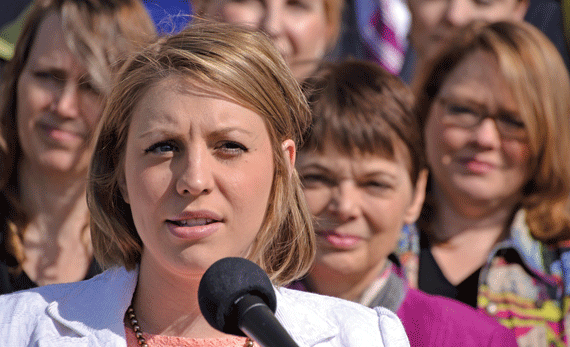

Share
Now, the U.S. workforce is virtually evenly split, half and half, male and female.
Two-thirds of mothers with children under the age of five work.
Seven of every dozen (58 percent) of mothers with newborns — children up to age 1 — work.
Today’s workforce is vastly different from that of the last century.
The stereotype of the U.S. workforce, harkening back to the 1950s, of Daddy going to work and Mommy staying home to take care of the kids is dead. And while it applied to white middle-class families then, it didn’t apply to African-Americans, Latinos or other minorities. Now it applies to fewer and fewer families of any race, creed, color or sexual orientation.
“More mothers and fathers are performing multiple roles than in the past,” says a joint report from two think tanks, the progressive Brookings Institution and the traditionally conservative, business-oriented American Enterprise Institute.
“In 1970, about half of married couples with children under 18 lived in a household in which the father was the primary breadwinner. By 2015, two-thirds lived in dual-earner households. At the same time, the fraction of children living with a single mother or single father increased: Nearly one-third of children today do not live in two-parent households.” Federal data show 5 percent of all children have no parents at home and the other 26 percent are in single-parent households.
But while the U.S. workforce has changed, U.S. workforce policies by and large have not. They’re still based on the assumptions and demographics of the 1950s. The report used the new data as part of its argument for enacting a federal paid family leave law to let parents care for newborns.
The U.S. has unpaid family leave, of course, after lobbying by women’s groups and unions forced Congress to enact it and President Bill Clinton (D) to sign the Family and Medical Leave Act in 1993. President George H.W. Bush (R) had vetoed it. But the FMLA only covers unpaid leave and exempts firms with fewer than 50 workers. That leaves millions of people out. Either workers don’t have it — only 59 percent do — or can’t afford it.
Paid family leave, pushed for at least a decade by Rep. Rosa DeLauro, D-Conn., author of the FMLA, has gone nowhere in Congress. Five states, Washington, D.C., and several big cities — including New York, Chicago, the Twin Cities and L.A. — have enacted it for various groups of workers.
Even Ivanka Trump, the GOP president’s daughter, endorses paid family leave for parents of newborns, and has talked her father into it, though his version is less generous than DeLauro’s. But other Republicans, both on Capitol Hill and in state legislatures, kowtowing to their business backers and ideologues who still hanker after the 1950s stereotype, still resist the idea of mandating it.
Even if the feds enact paid family leave for parents of newborns, many other U.S. policies need to adjust to the changing demographics of the workforce. Among them:
Jobless benefits. Some advocates urge extending them to parents of newborns who must miss work to take care of the babies. Several foreign nations have adopted that idea.
Flexible work hours. That idea would let parents spend more available time with their kids, even though most of their time is now spent at work. But congressional Republicans have perverted flexitime, as it’s called, into letting firms force workers into substituting comp time for overtime pay. Workers could take comp time sometime in the future, at the boss’ convenience. Overtime pay benefits the workers. Future comp time benefits the boss.
Higher pay for working women, especially working women in family-centered occupations. Caregivers, for both children and the elderly, are among the lowest-paid workers in the economy. Unions, notably the Service Employees, fought for better pay for them, even taking their cause all the way to the Supreme Court, where they lost. The Democratic Obama administration’s Labor Department tried to write new rules expanding eligibility for the minimum wage and overtime pay to more caregivers, over industry resistance.
Paid leave for workers’ own illnesses or those of other loved ones, notably their aging parents. The Brookings-AEI report says more data is needed to justify enacting those laws, while data is already available on the impact of paid family leave for parents of babies.
Extending temporary disability insurance to cover parents of newborns nationwide. California, Hawaii, New York, New Jersey and Rhode Island already do so. Small increases in payroll taxes on employers, employees or both, finance the extensions. One problem the Brookings-AEI report notes: “These programs typically pay 50 percent to 60 percent of wages, and women giving birth are typically eligible for 6-8 weeks” of benefits. But since the benefit is tied to a medical condition, childbirth, “it is unavailable to fathers or adoptive parents.”
And, finally, what to do about the widening gap between the rich and the rest of us, a gap that affects both sexes and all workers. “The share of Americans who live in middle class households is shrinking,” the Pew Research Center, another non-partisan think tank, reports. “The share of U.S. adults living in middle-income households fell to 50 percent in 2015, after more than four decades in which those households” were a majority.
“Financial gaps between middle- and upper-income Americans have widened, with upper-income households holding 49 percent of U.S. aggregate household income — up from 29 percent in 1970,” Pew adds. “Most Americans say the government doesn’t do enough to help the middle class, and neither political party is widely viewed as a champion for middle-class interests.”

